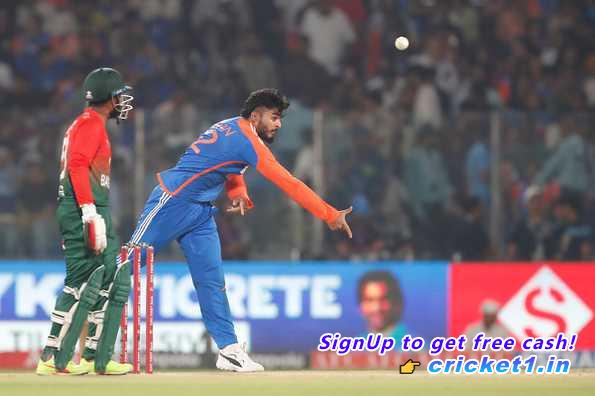
In Delhi, beyond their fearless display with the bat, India’s cricket team demonstrated another remarkable aspect of their gameplay: their increasingly diverse pool of bowlers. As many as seven bowlers contributed by taking wickets during the T20I match, setting a new record for India in this format. Surprisingly, Hardik Pandya, one of their key bowling assets, was not among those delivering with the ball.
Captain Suryakumar Yadav found himself spoilt for choice. Such was the depth in the bowling lineup that he neither needed to roll his arm over nor call upon Rinku Singh, who, not too long ago, played a pivotal role in tying a match against Sri Lanka. If he chose to do so, he could’ve easily fielded 10 bowlers across games in both Delhi and Gwalior. Luckily for the team, as per his hopes at the series outset, it never “came down to that.”
In the past, India’s reliance on pure batters who didn’t contribute with the ball was considered a vulnerability. However, with players like Axar Patel stepping up, this concern is gradually easing. The challenge was vividly evident during the last ODI World Cup when the team had to field merely four primary bowlers along with an all-rounder to fill the void left by Pandya’s injury.
The current squad, however, offers a refreshing change in terms of options and flexibility. With new entrants such as Nitish Reddy, who took the new ball in Delhi, and Riyan Parag, who proved his effectiveness in spin-friendly conditions in Sri Lanka, India is now better equipped. Abhishek Sharma, who boasts solid bowling credentials with over 134 T20 overs under his belt and impressive figures like 3 for 7, adds to this mix. Meanwhile, the duo of Suryakumar and Rinku, whose last-over heroics in Pallekele remain fresh in memory, emphasizes the strategic depth at the team’s disposal.
Indian assistant coach Ryan ten Doeschate expressed the value of having versatile players. “The game is evolving, and it’s uncommon to see all bowlers performing well on any given day,” he explained. “It’s beneficial to have these options. Hardik not bowling in the last game underlines the strength we have in our bowling lineup.”
Balancing roles is crucial, commented Ryan, indicating the importance of having a mix of specialists and multi-role players. “Too many frontline bowlers can be as problematic as too many batters. The multiple all-round options we have provide room to select a specialist bowler when needed, offering the captain many strategic choices.
.”
Ryan emphasized the importance of picking “carefully selected” players who can perform “multiple roles.” This approach has granted India unprecedented depth throughout the series, presenting both an opportunity and a challenge as they gear up for looming international tournaments like the World Cups and Champions Trophy.
He said, “This series showcases our depth. Our players’ ability to adapt and fill multiple roles is paramount for achieving squad balance, especially in different playing conditions. For instance, a player like Riyan could potentially play anywhere from four to five, anchoring or finishing innings as required. We aim to align all these aspects during bilaterals, while not losing sight of series victories.”
The series has also offered a chance to assess new entrants like Mayank Yadav and Nitish Reddy. Sharing insights about the team dynamics, Ryan noted the importance of understanding the capabilities and potential of debutants and other new team members like Jitesh Sharma, Tilak Varma, and Harshit Rana, as their performance could be pivotal in the upcoming 18 months.
Additionally, the depth extends far beyond those who have played so far. Despite not making appearances in the current series, players like Jitesh Sharma and Tilak Varma remain significant to the team’s blueprint. Sanju Samson, poised for another opportunity as a makeshift opener, and Harshit Rana, anticipated for a potential debut, represent the vast reservoir of talent that Indian cricket can draw from.
Ryan expressed the significance of giving international exposure to as many players as possible, saying, “Our objective is to familiarize more players with international standards ahead of significant tournaments. Someone like Harshit Rana is in our plans to gain match experience. Initially, the goal was to clinch the series and then experiment with a few fresh faces.”
Sanju Samson’s innings in Gwalior was highlighted as part of the team’s fearless batting philosophy. Ryan explained, “Sanju’s aggressive opening showcased our strategic approach. He could’ve settled for merely a decent score, but he chose to push boundaries, showcasing an understanding of the game shaped by consistent messaging.”
India’s current strategy leverages its rich talent pool, promoting a fearless yet calculated brand of cricket. By nurturing this mindset, they aim to push the envelope, preparing thoroughly for upcoming pivotal cricketing moments. “It’s about scoring and optimizing each of the 120 balls in play,” concluded Ryan, underscoring the team’s forward-thinking approach.

